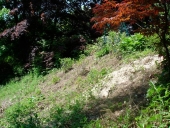You have a large area to work with.
You might want to consider defining zones, and keeping the labor intensive stuff to zones one and two. For the rest of the property, there are strategies less intensive which can get the land trending back to more mature and robust ecosystem.
Identify and mitigate runoff, beginning at the top of the property, to slow water down, spread it out, soak it in. Try to intercept it upstream of where it is cutting arroyos, if it is doing so.
You can also work within the arroyos, if they appear to be active and growing.
If the terrain is rocky, you can arrange rocks to form permeable dams of sorts. If you don't have rocks, you can lay downed tree limbs perpendicular to slope in order to slow the run-off. Where you do this, you will not just be slowing down and infiltrating rainwater, the topsoil and native seeds will tend to catch in the same places and will grow. They will in time become bigger water-harvesting structures, and can act in a positive feedback loop (they trap more water and topsoil causing more plants to colonize and grow trapping more water and topsoil and so on.)
If you have a pattern of late frosts there, the north slope will be the place to plant fruit trees and bushes. They will stay colder and bloom later in the spring, and not be quite as vulnerable to getting their buds killed by frost.
The junipers, much maligned, are self-mulchers and water harvesters. For this reason, they tend to be nurse plants to piñon. But you could likely take advantage of their behaviors by identifying the plants that like to hang out with them and planting the same or similar species (with human benefits) around their driplines. There's no good substitute for careful observation of what is already growing, but plants found in guilds around juniper include piñon, wolfberry, artemisia, ribes aureum, scrub oak. New Mexico permaculturist Ben Haggard wrote a paper on the Juniper-piñon guild associations which might be a useful guide.
https://docs.google.com/viewer?url=http://www.fs.fed.us/rm/pubs_rm/rm_gtr236/rm_gtr236_143_145.pdf&embedded=true&chrome=true

















 That's very different from here, when many or most ponds go dry during drought (our drought is their normal rainfall). Must be the difference in elevation/evaporation or something.
That's very different from here, when many or most ponds go dry during drought (our drought is their normal rainfall). Must be the difference in elevation/evaporation or something.




























